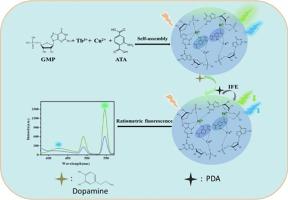Lanthanide coordination polymers as luminescent laccase mimics for ratiometric sensing of dopamine
IF 4.3
2区 化学
Q1 SPECTROSCOPY
Spectrochimica Acta Part A: Molecular and Biomolecular Spectroscopy
Pub Date : 2024-11-05
DOI:10.1016/j.saa.2024.125398
引用次数: 0
Abstract
Some metal ions, with inner enzyme-like catalytic activity, could be doped into lanthanide coordination polymers (Ln CPs) through coordination, which has been proved as a facile strategy to prepare the luminescent nanozymes. In this study, Cu-doped Ln CPs with laccase-mimic activity and double luminescence were rationally designed and synthesized by self-assembly of guanine monophosphate (GMP), 2-aminoterephthalic acid (ATA), Cu2+ and Tb3+ in buffer solution at room temperature. The obtained probes Tb/Cu-GMP/ATA CPs not only emitted green fluorescence of Tb3+ and blue fluorescence of ATA simultaneously under irradiation at the same wavelength, but also processed enhanced laccase-like activity for catalyzing the oxidation of phenolic substrates. Upon dopamine (DA), the probes catalyzed the oxidation of DA to polydopamine (PDA), which effectively quenched the fluorescence of Tb3+ due to the internal filtration effect. Based on this, a ratiometric fluorescent sensor for DA was constructed accordingly, and the corresponding fluorescence intensity ratio of Tb3+ to ATA (F547/F427) was linearly correlated with the DA concentration in the range of 1 to 400 μM, with a detection limit of 0.44 μM. Besides, this sensor could be used to detect DA in human serum samples with good recovery, which results were highly consistent with that of HPLC method. The constituent and luminescence tunability, as well as the extraordinarily facile synthesis, made Ln CPs a potential platform for designing and preparing the integrated multifunctional probe for special target in sensing applications.

镧系元素配位聚合物作为发光漆酶模拟物,用于多巴胺的比率测量传感。
一些具有类似内酶催化活性的金属离子可以通过配位掺杂到镧系元素配位聚合物(Ln CPs)中,这已被证明是制备发光纳米分子的一种简便策略。本研究通过单磷酸鸟嘌呤(GMP)、2-氨基对苯二甲酸(ATA)、Cu2+和Tb3+在室温缓冲溶液中的自组装,合理设计并合成了具有模仿漆酶活性和双发光特性的Cu掺杂Ln CPs。得到的探针 Tb/Cu-GMP/ATA CPs 不仅能在相同波长的照射下同时发出 Tb3+ 的绿色荧光和 ATA 的蓝色荧光,而且还能处理增强的类似漆酶的活性,催化酚类底物的氧化。在多巴胺(DA)的作用下,探针催化 DA 氧化为多巴胺(PDA),由于内部过滤效应,PDA 有效地淬灭了 Tb3+ 的荧光。在此基础上,构建了相应的 DA 比率荧光传感器,在 1 至 400 μM 范围内,Tb3+与 ATA 的荧光强度比(F547/F427)与 DA 浓度呈线性相关,检测限为 0.44 μM。此外,该传感器还可用于检测人血清样品中的DA,且回收率高,结果与高效液相色谱法高度一致。镧系氯化石蜡的成分和发光可调性以及极其简便的合成方法,使其成为设计和制备用于特殊传感应用目标的集成多功能探针的潜在平台。
本文章由计算机程序翻译,如有差异,请以英文原文为准。
求助全文
约1分钟内获得全文
求助全文
来源期刊
CiteScore
8.40
自引率
11.40%
发文量
1364
审稿时长
40 days
期刊介绍:
Spectrochimica Acta, Part A: Molecular and Biomolecular Spectroscopy (SAA) is an interdisciplinary journal which spans from basic to applied aspects of optical spectroscopy in chemistry, medicine, biology, and materials science.
The journal publishes original scientific papers that feature high-quality spectroscopic data and analysis. From the broad range of optical spectroscopies, the emphasis is on electronic, vibrational or rotational spectra of molecules, rather than on spectroscopy based on magnetic moments.
Criteria for publication in SAA are novelty, uniqueness, and outstanding quality. Routine applications of spectroscopic techniques and computational methods are not appropriate.
Topics of particular interest of Spectrochimica Acta Part A include, but are not limited to:
Spectroscopy and dynamics of bioanalytical, biomedical, environmental, and atmospheric sciences,
Novel experimental techniques or instrumentation for molecular spectroscopy,
Novel theoretical and computational methods,
Novel applications in photochemistry and photobiology,
Novel interpretational approaches as well as advances in data analysis based on electronic or vibrational spectroscopy.

 求助内容:
求助内容: 应助结果提醒方式:
应助结果提醒方式:


